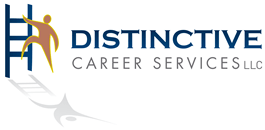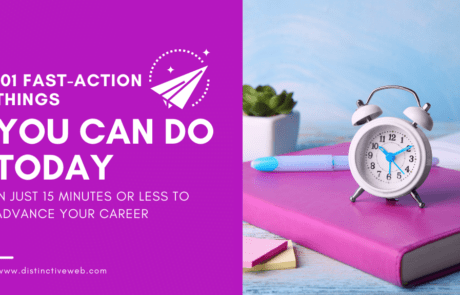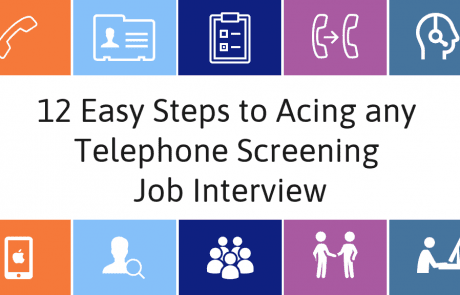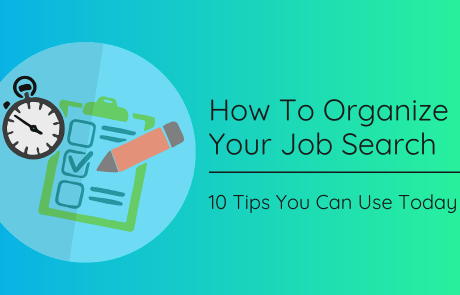
Is your resume generating disappointing results?
Have you been sending it for positions you know you are qualified for, but the phone remains silent?
If so, you need to know how to fix your resume, and you need to know how to fix it fast. These ten fast and easy fixes you can make before you apply for the next job will help.
Remove Your Resume Objective Statement
But wait!? I know what you are thinking. You have heard that you should ALWAYS include a resume objective. So now I am telling you to remove it?!
Well, yes. But not quite the way you think. The objective of your resume is essential because it creates the focus for your resume. So, you must still focus your resume. But, there is a more modern way of focusing your resume than an objective statement.
Let me explain…
As you work to fix your resume, one significant rule to keep in mind is that you should phrase all of your content so that it is employer-centered.
Objective statements that tell the reader what you want are inherently self-centered. The modern way of providing focus is to include a professional summary or profile section (aka summary statement) with a focusing headline.
A profile is fundamentally different from an objective in that it is employer-centered, conveying to the reader what you offer them rather than what you want from them.
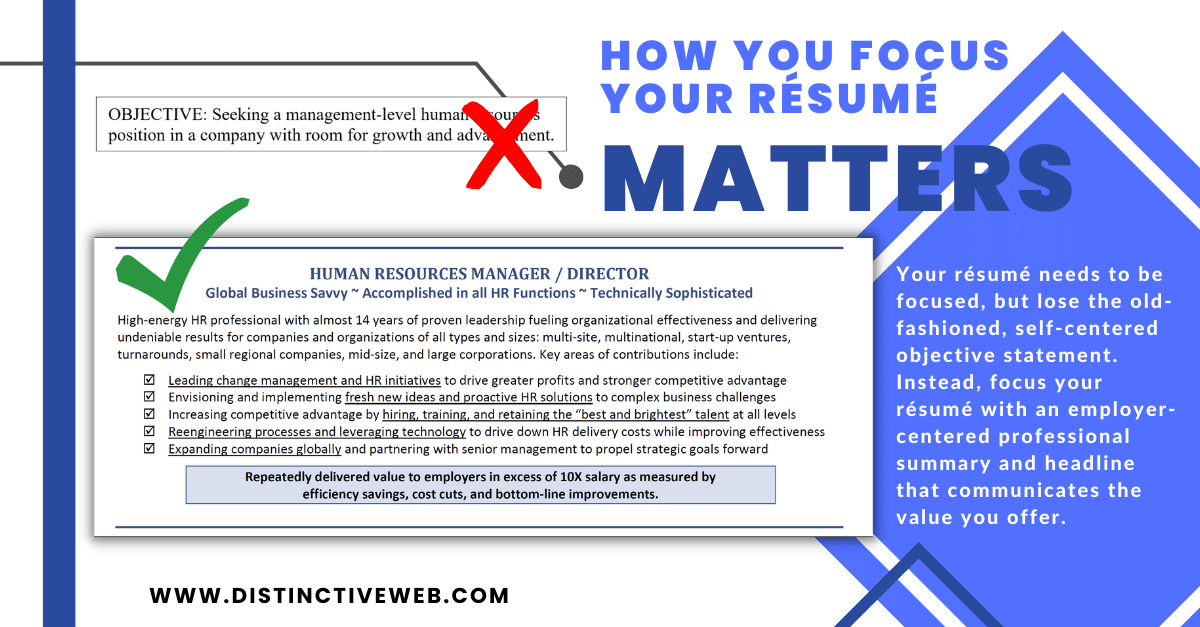
Don’t Be Afraid Of Pigeon-Holing Yourself
Submitting a “general” resume is a mistake you never want to make!
Many job seekers will write a broad, general resume out of fear that focusing too precisely will exclude them from specific opportunities. Unfortunately, this strategy is a resume-writing mistake that almost always backfires.
Resume readers are notoriously lazy and give your professional resume only a few seconds before deciding to screen it out or screen it in.
If you are lucky, you have 15 seconds to clearly convey your focus (level and type of position you seek) and how you would add value to their organization.
If your focus is ambiguous and you haven’t made it crystal clear how you will “fit” in the company, you certainly can’t expect the reader to make an effort to figure it out.
Yes, I know that you are probably qualified for more than one job description and that you might consider various jobs. But this doesn’t mean you should write a single resume for all of them.
A good solution that works for many job seekers is to write a master resume that you customize for each job application, tailoring the significant skills that will be important to each hiring manager.
For this customized version of your resume, read the job posting carefully and then tailor all of the content–your resume summary, skills section, work history, and even your education section–to focus on only your relevant experience.
Make Sure You Are Using the Best Resume Format for You
Career advice regarding resume formats can be confusing.
For example, you may have been told you should use a functional resume format. But is this really the right format for you? Probably not–unless you are looking to change careers entirely.
The combination format is a better format for most professionals. Resumes structured in the combination format will include a resume header with your contact information, including a professional email address, phone number, and LinkedIn profile URL; then a strong resume summary; followed by your most recent job and past experience in reverse chronological order; then ended by your education.
You may include other relevant details too. For example, you might write a skills section. A skills summary gives you a place to list hard skills that are especially important for the job to which you are applying.
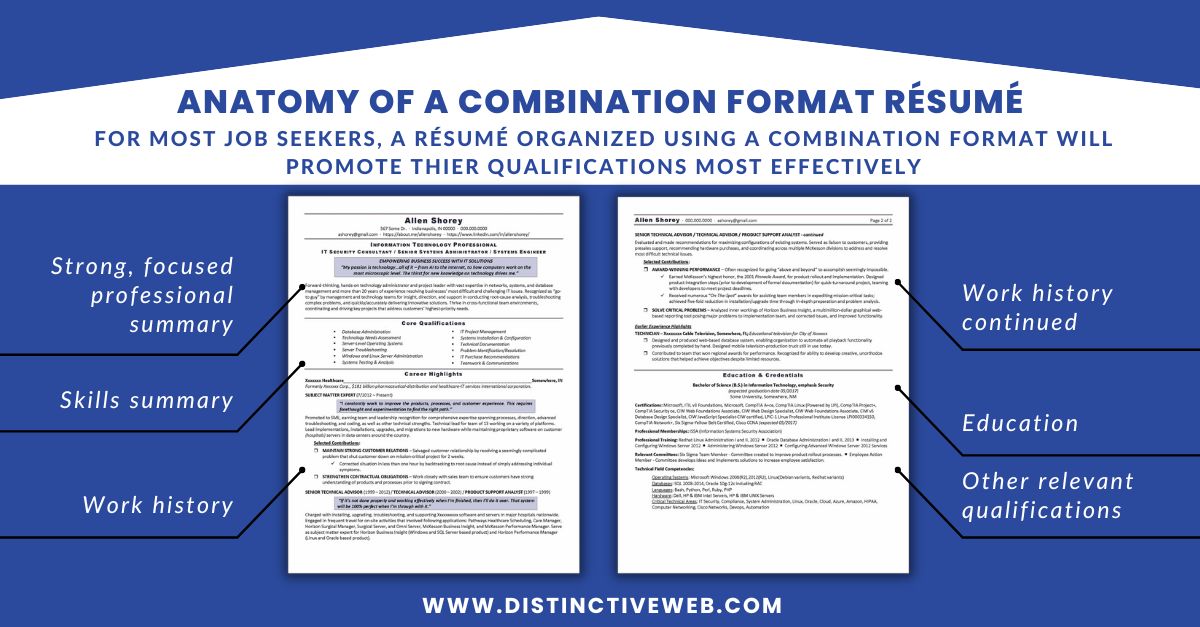
Another common resume writing mistake is overemphasizing education. If you are an experienced professional, your prior jobs and accomplishments are far more important than your degrees. Usually, only a recent graduate with very little or no experience should list education at the beginning of the resume before work history.
You must prioritize and organize your selling points, listing sections of primary importance first in your resume. The combination format will give you a lot of flexibility to do this.
Optimize For Both Humans & Applicant Tracking Systems
In many ways, your resume’s first impression on a hiring manager is based on its appearance.
You should never use a cookie-cutter resume design to create a resume. Instead, you should design your resume to highlight your unique qualifications and selling points and to set you apart from other candidates. Color and subtle design elements are common in modern professional resumes.
Resume templates are available, but if you use an obvious template, you ensure that your resume will blend in with all the rest. Worse, many resume templates may look eye-catching but are incompatible with applicant tracking systems.
An applicant tracking system (ATS) is the digital system used by most recruiters and large employers (and some small employers, too) to track job applicants throughout the hiring process.
When you apply for a job, your resume will be entered into an ATS and later searched by keywords to identify the best-qualified job applicants.
To generate optimal results, your resume must attract immediate attention and present an unquestionably professional appearance while also being compatible with ATS. This is a challenging order to fill and is one of the many good reasons working with a professional resume writer is a good idea.

But if you do go it alone, well-constructed and designed ATS-friendly resume templates can greatly help you win a competitive edge. Just be sure to purchase the template from a reputable source such as Distinctive Resume Templates.
Focus Your Resume on Accomplishments, NOT Responsibilities
Think about it: Being “responsible for” doing something certainly doesn’t mean a person does it. What a person is supposed to do and what they actually do are two different things.
I have often explained it this way: When my daughter was a child, she was “responsible for” cleaning her bedroom. Did she do it? Rarely. And when she did, not very well.
Imagine if I were to write a resume focused on her responsibilities: “Responsible for making the bed and neatly putting away all toys and shoes daily.”
The hiring manager reading that statement learns nothing about her or the value she is capable of delivering
Many people make the mistake of emphasizing features (responsibilities) rather than benefits (achievements/results) on their resumes.
Instead, to fix your resume and get better job search results, it is imperative to emphasize achievements, quantifying results whenever possible.
Imagine if instead of focusing my daughter’s resume on what she was supposed to do, I focused on what she did do:
- Saved mom 30 minutes daily by helping her set and later clear the dinner table five nights per week.
- Assisted with weeding a 10’x20’ kitchen garden plot, resulting in harvesting 15 pounds of tomatoes, 12 pounds of cucumbers, and several bushels of other vegetables.
These are some silly examples. Obviously, I wouldn’t be writing a resume for my nine-year-old child. But you get the point. It is much more powerful to focus your resume on what you did and the results of what you did.
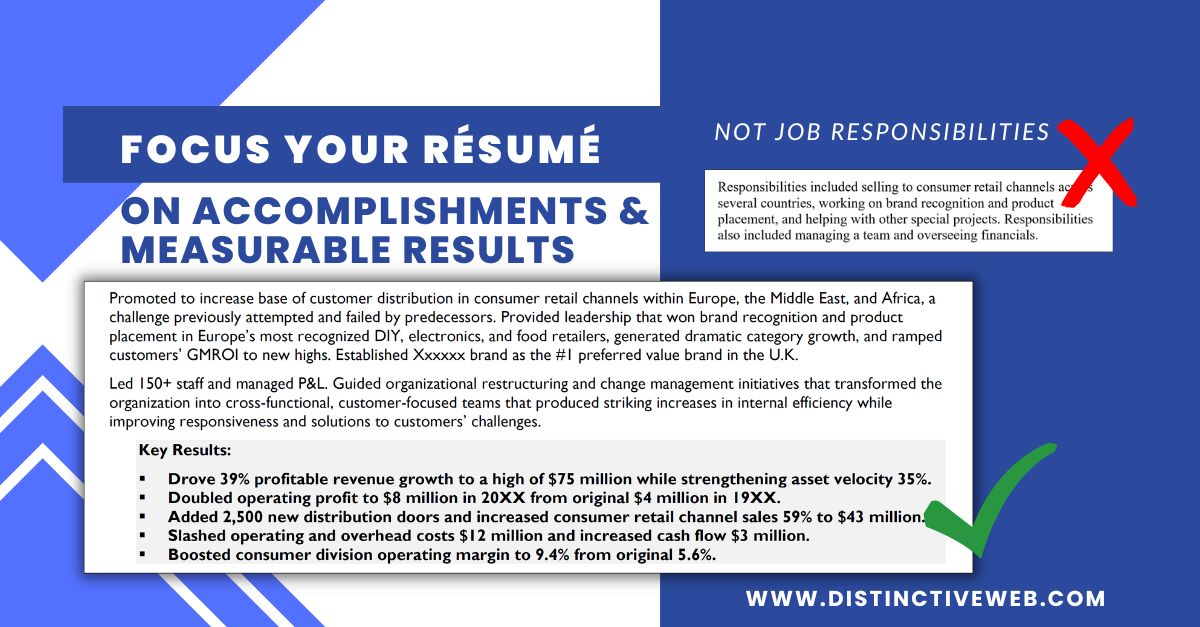
Document how your work has benefited your employers, include bullet points to call these accomplishments out, and quantify them whenever possible. You demonstrate your future potential by including past achievements and results in your resume.
What did you improve, save, increase, enhance, etc? What impact did the work you do have on the companies?
Using bullet points in your resume design to break out each accomplishment will help them stand out while also helping make your resume easier to read.
Always remember, you won’t get hired for what you know how to do; you will get hired for what you do with what you know how to do.
The example resumes in our portfolio are filled with quantified accomplishments and will give you ideas on applying this principle to your resume.
Remove the Clichés
Vague soft skills, stale jargon, and overused buzzwords should have no place on your resume and can harm your credibility. Hiring managers and recruiters are interested in what you have done and how you have contributed.
Flowery language and clichés without fact-based accomplishment statements to prove them will hurt you rather than help you.
Avoid words and phrases such as hardworking, detail-oriented, self-motivated, team player, go-getter, or outside-the-box thinker unless you also provide concrete examples that prove and illustrate your claims.
Eliminate Irrelevant Details
Your resume is a marketing document. It is not an autobiography.
While the decision about how far back to date your resume depends on your individual circumstances, generally, it is standard to go back 10-20 years. If experience earlier than that is still relevant, you can always summarize it in a couple of sentences without using dates.
Always think in terms of relevance and impact. For example, does a particular piece of data or achievement support your personal brand and resume value proposition?
Does it help promote your qualifications concerning your current career goals?
If not, you probably should not include it. In fact, by including irrelevant data, you dilute your resume and make the recipient wonder if you truly understand the position you are targeting.
If you have a college degree, for example, you will probably want to leave your high school diploma off your resume. It simply isn’t relevant anymore.
If you feel strongly that particular data may be relevant to at least SOME recipients, you can always create a resume addendum that you choose to use selectively. Or, go back to my previous advice about creating customized versions of your resume.

Remove Personal Details
Is your resume meant for the U.S. job market? If so, it should not include a photo, birth date, mention of unrelated hobbies or interests, information about your family, information that reveals your religion, or any other similar personal data.
Including such data in a resume meant for the U.S. market may actually eliminate you from consideration, as hiring managers may be concerned about discrimination suits.
Edit, Edit, Edit
While the usual career advice is that your resume should never be longer than three pages, beyond that “rule of thumb,” the number of pages that make up a perfect resume is subjective.
In general, it is helpful to remember that the more pages, the less likely your resume will be read (at least, read in full).
I’ve already advised you to remove older content, irrelevant details, and personal information. Editing in this way saves space for more critical content. But don’t just fill the pages because you have the space available. Instead, edit, edit, edit until you are sure every detail and word in your resume serves a purpose.
A one-page resume is likely just right for you if you are a recent graduate or applying for your first job.
But, as you gain some experience, it is common and expected that your resume might fill two pages. Executives and people who work in technical professions that require lots of technical skills may find they need to create a three-page resume.
If you have a lot of skills and are having trouble keeping your resume to a prescribed length, a resume addendum might be a good solution. An addendum will give you the extra space to include skills on a document separate from your resume. For example, you may want to create a listing of programming languages you have proficiency in, publications you’ve authored, speaking engagements, leadership skills, or anything else you think is relevant to your career goals.
Proofread Carefully
One of the most common mistakes people make when creating a resume is not proofreading the resume carefully for spelling and grammatical errors.
This might seem like a small detail, but trust me, it makes a big difference.
Grammatical and spelling errors on your resume give the impression that you are unprofessional and careless. If you want to make an excellent first impression, take the time to proofread your resume to ensure it is 100% free of grammar errors before submitting it.
Using proper grammar shows that you are attentive to detail and take pride in your work. Conversely, sloppy grammar reflects poorly on you as a candidate and can hurt your chances of getting an interview, let alone your dream job–or any job, for that matter.
Here are some tips on how to proofread your resume:
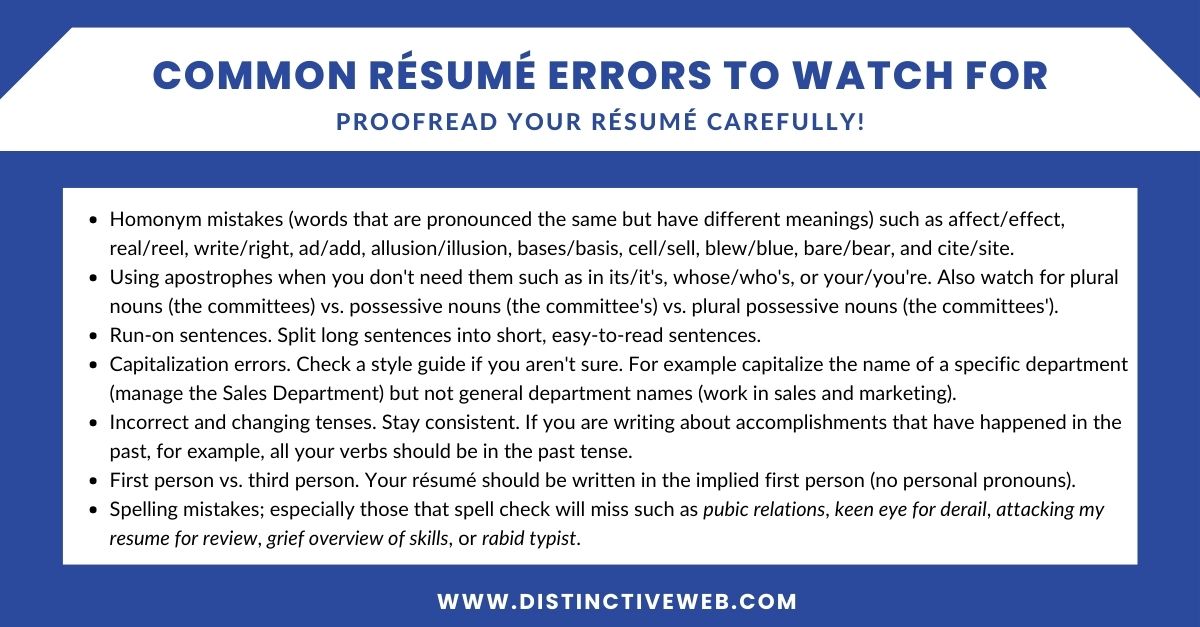
Final Thoughts
A professional resume is one of the most important documents you will ever create.
It is a document that represents you and your career and should be treated as such. A well-written resume can open doors and lead to exciting opportunities, but a poorly written resume can do the opposite.
While writing a perfect resume might seem like an unattainable goal, you should strive for a perfect resume. It is well worth your time to fix problems and refine your resume.
However, your best option is to hire a professional resume writer. Even if you think your resume is perfect, there is an excellent chance that a professional resume writer can perfect it even further. While working with a resume expert is an investment, it is an important investment that will almost always pay you back many times over.
To learn more about our professional resume writing services and how we might be of help to you, schedule a free resume writing consultation today.
